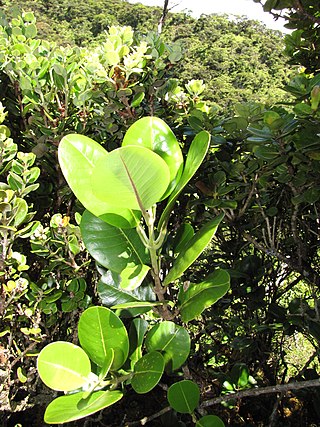Melicope balloui, also called Ballou's melicope or rock pelea, is a species of plant in the family Rutaceae. It is endemic to the Hawaiian Islands. It is threatened by habitat loss. Like other Hawaiian Melicope, this species is known as alani.
Melicope christophersenii is a species of plant in the family Rutaceae known by the common name Waianae Range melicope. It is endemic to the Hawaiian Islands. It is threatened by habitat loss. It was named in honour of Erling Christophersen.
Melicope cinerea is a species of plant in the family Rutaceae known by the common name manena. It is endemic to the Hawaiian Islands. It is threatened by habitat loss.
Melicope cruciata, also called pilo 'ula or cross-bearing pelea, is a species of plant in the family Rutaceae. It is endemic to the Hawaiian Islands.
Melicope haleakalae, Haleakala melicope, is a species of plant in the family Rutaceae. It is endemic to the Hawaiian Islands. It is a perennial shrub or tree that grows up to 10 ft (3.0 m) tall. It grows in wet forests.
Melicope haupuensis is a species of tree in the family Rutaceae known by the common names Haupa Mountain melicope and Pacific pelea. It is endemic to the Hawaiian Islands, where it is known only from the island of Kauai. It is threatened by habitat loss. It is a federally listed endangered species of the United States. Like other Hawaiian Melicope, this species is known as alani.
Melicope kaalaensis is a species of plant in the family Rutaceae known by the common name Kaala melicope. I

Melicope knudsenii, commonly known as Olokele Valley melicope or Knudsen's melicope, is a species of flowering plant in the family Rutaceae, that is endemic to Hawaii. It inhabits montane mesic forests dominated by Acacia koa, Metrosideros polymorpha, and Dicranopteris linearis on Kauaʻi and East Maui (Auwahi). Associated plants include Syzygium sandwicensis, Cheirodendron trigynum, Myrsine lessertiana, Ilex anomala, Alphitonia ponderosa, Zanthoxylum dipetalum, Kadua terminalis, Pleomele aurea, Bobea spp., Tetraplasandra waimeae, Xylosma hawaiensis, Eurya sandwicensis, Psychotria mariniana, Melicope anisata, Melicope barbigera, Planchonella sandwicensis, Dodonaea viscosa, and Dianella sandwicensis. It is threatened by habitat loss. Like other Hawaiian Melicope, this species is known as alani. This is a federally listed endangered species of the United States.
Melicope macropus, the Kaholuamanu melicope, was a species of plant in the citrus family, Rutaceae.
Melicope makahae, the Makaha Valley melicope, is a species of plant in the family Rutaceae. It is a perennial shrub or tree that grows up to 10 ft (3.0 m) tall.

Melicope orbicularis, also called Honokahua melicope or orbicular pelea, is a species of plant in the family Rutaceae. It is endemic to the Hawaiian Islands. It is threatened by habitat loss.
Melicope ovalis, the wild pelea or Hana melicope, is a species of tree in the family Rutaceae. It is endemic to Maui, of the Hawaiian Islands.
Melicope pallida, the pale melicope, is a species of tree in the family Rutaceae. It is endemic to the Hawaiian Islands. It is threatened by habitat loss. It is a federally listed endangered species of the United States. Like other Hawaiian Melicope, this species is known as alani.
Melicope paniculata, the Lihue melicope, is a rare species of tree in the family Rutaceae. It is endemic to the Hawaiian Islands. Like other Hawaiian Melicope, this species is known as alani.
Melicope puberula, the hairy melicope, is a species of plant in the family Rutaceae. It is endemic to the Hawaiian Islands. Like other Hawaiian Melicope, this species is known as alani. In 2010 it was added to the endangered species list of the United States.
Melicope quadrangularis, also called four angle melicope or four-angled pelea, is a species of plant in the family Rutaceae. It is endemic to the Hawaiian Islands, where it is known only from the island of Kauai. It is threatened by habitat loss.
Melicope sandwicensis, the Mt. Kaala melicope, is a species of plant in the family Rutaceae.
Melicope wawraeana, the Monoa melicope, is a species of plant in the family Rutaceae. It is endemic to the Hawaiian Islands.
Melicope remyi, synonym Platydesma remyi, the Hawai'i pilo kea, is a species of plant in the family Rutaceae. It is endemic to the island of Hawaii. It is threatened by habitat loss. It is on the IUCN Red List of Endangered species.

Cornutia obovata is a rare species of tree in the mint family, and formerly considered a member of the verbena family. It is endemic to forested slopes in Puerto Rico, where its common names are capá jigüerilla, nigua, and palo de nigua. When it was added to the endangered species list of the United States in 1988 there were only seven individuals known to remain in the wild. By 1998 there were eight plants known. This is considered one population divided amongst a few locations in the mountain forests of the island.




